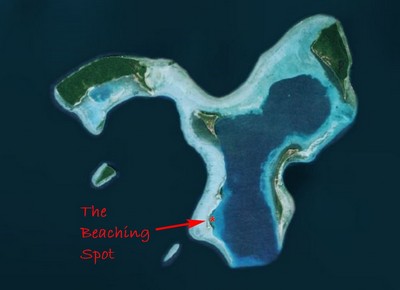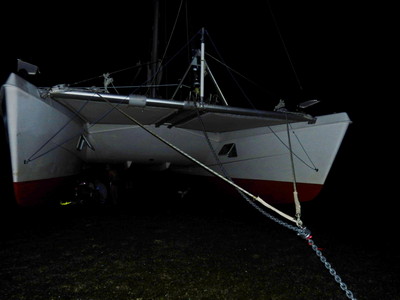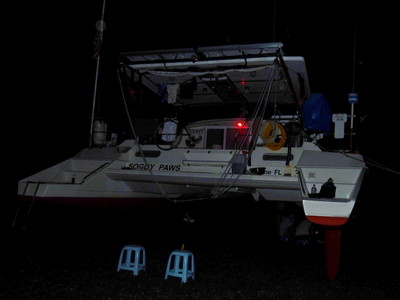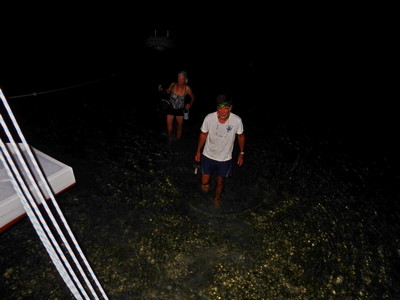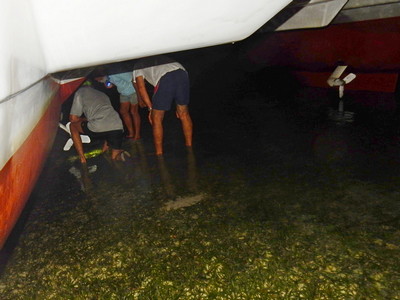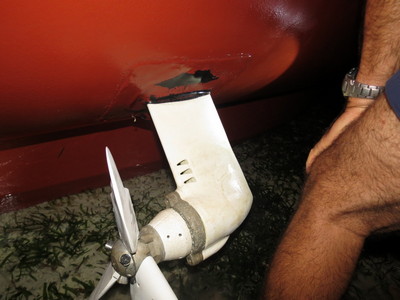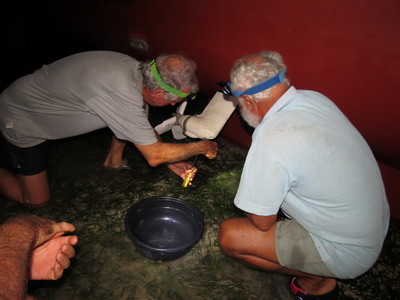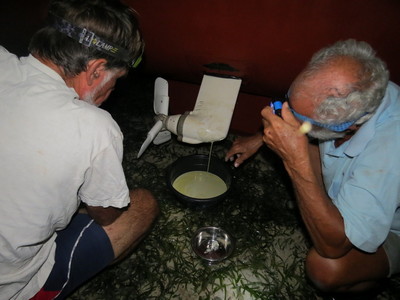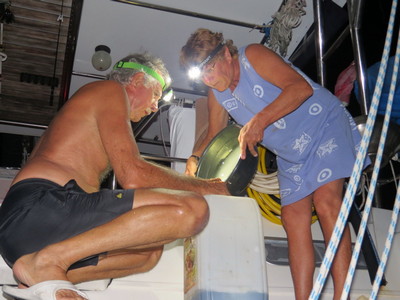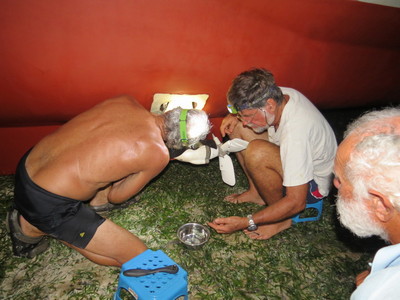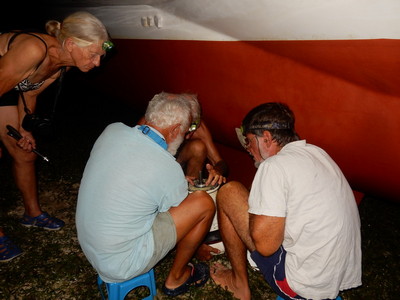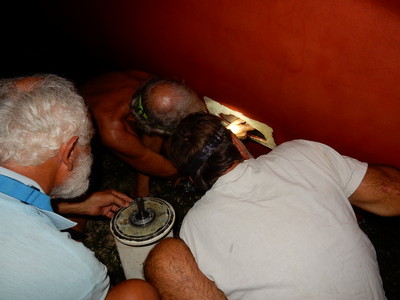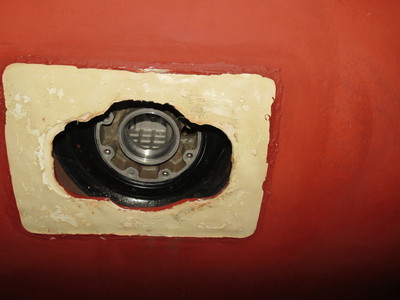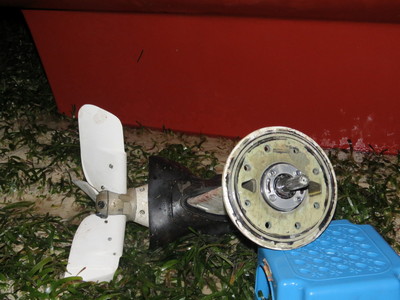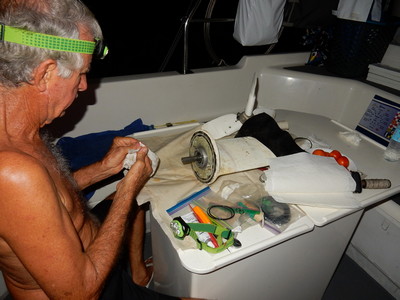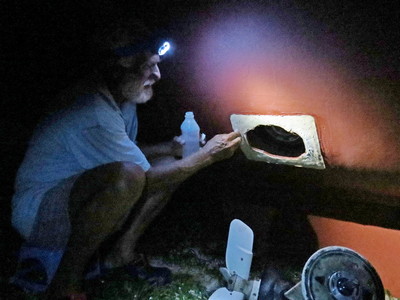The Ninigos are a large atoll with a few surrounding small atolls, that lie roughly 140nm off the coast of New Guinea, just northeast of Vanimo, the westernmost city on the north coast of New Guinea. It is possible to day hop down the coast, along coastal Irian Jaya Indonesia and into coastal Papua New Guinea, to within a short overnight sail of the Ninigos. Both because the coast of New Guinea is considered dangerous (because of social issues) and because in NW season, any anchorage we could find would be swelly, we decided to do it as a direct shot of 460nm almost due west from the islands east of Biak.
The forecast looked like it would be a slow passage, with winds on our port quarter at 10 knots, plus a little helping current, we expected to have a nice drift and arrive in 4-5 days.
It started out that way, with sunny skies and 8-12 knots WNW. We all (4 boats--us and Ocelot, Indigo II, and Berzerker) had our anchors up by 9am. For the first hour we threaded our way through the last atoll, and then around 10am, we turned the engine off and were actually sailing! Everyone else had their big sails out, but just as we were finally getting around to thinking about putting up our Code Zero (a big light air jib on a furler), the wind came up a bit and we decided to stick with the working jib.
Everyone has AIS, so it was fun to keep track of who was where and how fast they were going. We managed to stay within a few miles of Indigo for the whole 460 miles, but Ocelot and Berzerker (a 37' mono) gradually fell far enough behind that we couldn't pick them up on radar.
By late afternoon, with 15-20 knots of wind, we put a reef in the main. With a 1 knot following current, we were still zipping along at 8-9 knots speed over ground (SOG)! Later that evening, I calculated that if we averaged more than 6.5 knots, we'd arrive in the middle of the night. (We'd been averaging about 7.5 knots all day). And we'd have to average 8.1 knots to arrive in the late afternoon--not happening. Fortunately, the wind started easing a little overnight.
Dave and I are still on 6 hour night watches. We have an early dinner, and then I take the watch from sunset to about 1am. Then Dave takes it from 1 am to about 7am. The time shifts a little based on when sunset and sunrise actually are, and whether Dave really gets off to be around 7pm. But we try to each get 6 hours off watch, so we can get a good deep sleep. When you are on watch, a 6 hour watch is a long time, especially in challenging weather on a dark night. But it's worth it to get a solid block of sleep. After trying 3 and 4 hour watch schedules, this is what we have stuck with for the last 10 years.
On Day 2, dawn showed overcast skies and light winds. Around 10am the wind was light and almost dead behind us, so we motored most of the middle of the day to keep moving. Around noon, with both of us below doing something, we felt a thud on the hull and then another. We had hit a 12" diameter log, 20 ft long, crosswise on the port hull. And it was stuck between our keel and our rudder.


We pulled back the power immediately. We had been motoring on the port engine and feared for damage to our rather fragile saildrive. We were still moving enough to keep the log pinned to the forward side of our port rudder. Dave dumped the mainsail and I turned a little, and the log finally slid out. The engine seemed to be working OK, with no odd noises or vibrations. It was sloppy enough seas-wise that neither of us wanted to get in the water to take a look. So we powered up and kept on. (Note: at this point, Dave still hadn't resolved the cooling water issue on the starboard engine).
A few hours later, with the wind getting lighter and lighter, we went to put up the Code Zero. While we were messing about on the foredeck, I could hear what sounded like an odd-sounding whine coming from the port engine. With no sails up and the power back, and much calmer seas than earlier, I jumped in to take a look at things. Fortunately, the saildrive and prop looked untouched. The log must have bounced off the keel and totally missed the saildrive. The leading edge of the rudder was another matter. There was a softball sized dent in the leading edge of the rudder. Fortunately, the impact didn't seem to have hurt the rudder shaft.

Once we finally got the Code Zero up, after sorting out things after our hurried takedown a few weeks earlier, the wind started rising immediately, so we took it right back down. We finally turned the engine off about 4pm, and at 5:30 put a nighttime reef in the main. We were still doing 6+ knots over the bottom, in part due to the 1.5 knot current behind us. Near midnight I logged that we were doing 8.5 knots, and that I heard a thunder rumble. But with no moon it was hard to tell what was happening weather-wise.
Day 3 was full of squalls with rain and wind to 30 knots (none of which was in the forecast). With two days of solid overcast, and the extra power requirements of the instruments and the autopilot, we were worrying about low batteries. I started managing the refrigeration systems, turning the thermostat up on the freezer, and turning the fridge off during the night hours. The fridge needed a good defrost anyway!
In the middle of the day, I logged that we had taken the main completely down, as the wind was dead behind us. And we only had 10 feet of the jib out, and we were still doing 7 knots. We spent the rest of Day 3 and overnight with just the jib out, using it to control our speed so we would arrive at the pass around 7:30 am. Once the wind died down, we were left with huge seas and not much wind, but with the current and a full jib, we could still make 5 knots easily, but it was uncomfortable sloshing around like that.
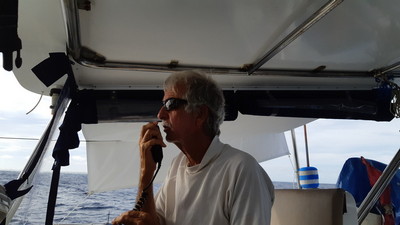
We were in VHF and HF contact with Ocelot, who was only 15 miles behind us. They could just reach Berzerker, who was another 25 miles behind them. So our little band carried on for a 3rd night. It was another squally night, with winds up and down, and some rain.

At 7:30 am, we were entering the SW pass at Ninigo, just behind Indigo. We saw a least depth of about 45 feet in the pass, and then it deepened up to 100-150 feet once inside the lagoon. The pass is well protected from the NW swell, so it was an easy entry, with little to no discernable current.
We had another 9 miles across the lagoon to make it up to Longan Island, on the NW corner of the atoll. Though this was the smallest village, this looked to be the best protected from the WNW-NW winds we were experiencing. The western side of the atoll was pretty open to the swell, so the anchorages inside the lagoon off the eastern islands would not be very good.
We had fairly rough conditions going NE to Longan, but thankfully we were squall-free during this time. We could see the scattered reefs and coral bommies on our satellite charts, but they were difficult to see visually in the overcast low-light conditions. Fortunately the GoogleEarth charts are spot on, and as long as we stayed on track, we stayed in depths over 100 ft deep.
At 0935 on Monday Jan 28, we anchored next to Indigo of Longan Island in 45 ft of nice sand, at 01-13.322S / 144-17.96E.
-----
At 1/28/2019 2:15 AM (utc) our position was 01°13.32'S 144°17.96'E
http://svsoggypaws.com/currentposition.htm
